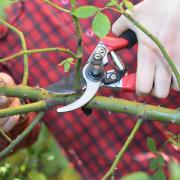When you spend a lot of time perfecting your garden over the summer, it can be extremely deflating to see this hard work unravel during a spate of wet weather.
As autumn commences, a flurry of downpours becomes more likely – so what plants do we need to keep an eye on and is there anything we can do to reduce significant damage to our gardens?

What impact does heavy rain have on our gardens?
Sudden shifts from sunshine to heavy rain can place plants under stress, as it can affect their ability to regulate water uptake.
“During dry periods, plants reduce their water absorption to conserve moisture, but a sudden deluge can lead to waterlogged roots, preventing them from taking in oxygen,” explains Oliver Hill, founder of the gardening site Garden List. “This can slow growth, cause leaves to yellow, and increase the risk of diseases such as root rot.”
Delicate plants such as roses can also be badly affected by heavy rain.

“Plants with delicate foliage and blooms, such as roses, peonies, and some herbaceous perennials, are particularly vulnerable,” says Hill. “Heavy rain can waterlog flowers, causing stems to bend or break.
“Similarly, plants in poorly drained soil, like succulents, are highly susceptible to root damage as they aren’t adapted to waterlogged conditions,” adds Hill.
Large amounts of rain can also have a negative impact on the soil.
“Excessive rain can lead to soil compaction, erosion, and nutrient leaching,” says Hill. “Waterlogged soils deprive plant roots of oxygen, making it difficult for plants to absorb essential nutrients. In clay-heavy soils, this can be even more problematic, leading to standing water and further compaction.”

So, what can we do to stop this from happening?
Tips to prepare for the rain
Before heavy rainfall hits, there are a few things you can do to reduce the potential damage to your garden.
“Check drainage,” advises Hill. “Ensure gutters, drains, and water run-off areas are clear.”
The gardening expert also recommends mulching your garden – i.e, adding a thick layer of organic matter (usually manure, compost or bark) onto the soil on your flower beds – to help absorb excess water and protect soil structure.

In addition, make sure you give your delicate plants some extra care and support.
“Staking or providing support for tall or top-heavy plants will help prevent them from collapsing,” explains Hill.
He also recommends moving all your pots and containers into a sheltered space.
“Place them in sheltered areas to avoid them becoming waterlogged or damaged by the force of the rain,” suggests Hill.
What should we do during the downpours?
“During heavy rain, it’s important to monitor your garden for pooling water or damaged plants,” says Hill. “If safe, you can divert excess water away from areas prone to flooding using channels or temporary barriers.”
He also urges gardeners to avoid walking on soaked soil, as this can compact it further.
How can we refresh our gardens after a spate of heavy rain?

Once the rain has passed, Hill advises gardeners to first of all check for and repair any damage to plants and supports and to remove any debris or silt that may have accumulated.
“You can also lightly aerate the soil with a fork to help improve drainage,” says Hill. “If your garden is waterlogged, consider using sand or compost to improve drainage in problem areas.”

He also recommends applying a light feed to replace any nutrients that may have been washed away.


























